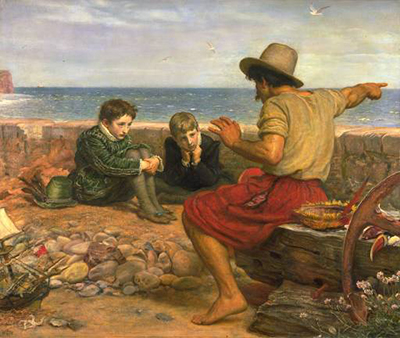John Everett Millais is popular for having created The Boyhood of Raleigh, a painting that was exhibited at the Royal Academy in 1871.
He created the oil-based painting in 1870 which came to epitomize the heroic imperialism culture in late Victorian Britain till the mid-twentieth century. He made the painting on canvas support and its dimensions are 48 cm (18.9 in.) width by 56 cm (22.0 in.) height. The painter has used the seagulls in the painting to show depth by the manner in which they appear receding into space with distance. The colour of the sea water also shows depth as it becomes darker with distance. The land mass on the right of the painting and where the sailor is pointing at (the direction of his hand) gives the painting an effect of two point/oblique perspective.
The painting was inspired by Sir Walter Raleigh, who was one of the most popular explorers of the Elizabethan age. In The Boyhood of Raleigh, Millais is shown as a boy listening with keen attention to ‘tales of wonder on sea and land’ which is told by a Genoese sailor. There is a toy in the foreground, which suggests Raleigh’s future expeditions. There is a sharp edge on the right, which may allude to the last words he said at his execution, ‘Strike, man, strike’. The boys sitting at the beach by the Devonshire coast, are Everett and George, who are Millais sons whom he used as models for the painting. The sailor was a professional model, a biographer, and Millais’ friend. It is said that the sailor is pointing at the ''Spanish main’’.
John Everett Millais was among the founding members of the Pre-Raphaelite movement, but by the time he created The Boyhood of Raleigh, he was mostly influenced by Old Masters. He painted The Boyhood of Raleigh at Budleigh Salterton, which was a location close to Raleigh’s birthplace. This painting was inspired by James Anthony Froude, on England’s Forgotten Worthies, that described the lives the Elizabethan sailors lived. The Boyhood of Raleigh was probably influenced by the biography of Raliegh, that imagined the experience he had from listening to tales from old sailors when he was a boy. He had to travel to Budleigh so that he could paint the location.




